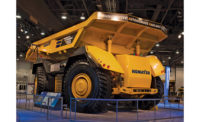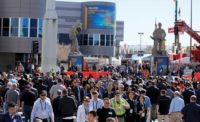Consolidation and management of coal-ash is dirty, dangerous work, and heavy equipment brought in to shift and compact the waste from coal-fired power plants can pose a hazard for workers. Unstable ground conditions and risk of exposure to hazardous materials are the norm, and safety concerns restrict how contractors are able to tackle the job.
But Birmingham, Ala.-based heavy civil contractor Saiia is looking to new technology to meet these cleanup goals. The company has deployed several remotely operated pieces of heavy equipment at an Alabama coal-ash site that allow the operators to run them from a trailer near the site. Caterpillar excavators and dozers are able to move and consolidate the coal ash without having the operators traverse the site or get in and out of the cab.
“We have been using this remote-control technology in a pilot and are now moving it into production,” says Frank Montgomery, president of Saiia, a subsidiary of IEA. Working with their Birmingham-based Cat dealer Thompson Tractor, Saiia got hold of remote operation kits for two Cat 340 long-reach excavators and a Cat D6 dozer and set them up at the coal-ash site next to a coal-fired power plant in Alabama.
“That tractor is a quarter-mile away, but we could operate it from our corporate office,” says Montgomery. “We elected to have them on site so the operators can talk to the superintendents.”
The remote-control system consists of a recreation of the cab controls with a set of screens showing live views around the machine. The low-latency WiFi-based connection allows the operator to drive the machine with a degree of finesse comparable to being in the actual cab.
Coal-ash work is normally slow going. Consolidation of coal combustion residuals, or coal ash, involves stacking and dewatering the material, and requires periods of waiting for it to dry out. “There’s danger in operating typical equipment in this kind of site,” says Montgomery. “We’ve had zero safety incidents at Saiia, but things happen in this industry.” The vibration and compaction from heavy equipment moving on an ash layer over the water table can cause the ash to liquefy, putting workers at risk. “Safety is a top priority in this work,” he says.
“Saiia was looking for all alternatives to take the operator out of harm’s way,” recalls John Smith, equipment management consultant at Thompson Tractor. “They had some questions on automation, and Cat just happened to be in the testing phase for these [remote-control] excavators.” After a demonstration of the technology at Caterpillar’s proving ground near Peoria, Ill., Montgomery was sold. “We came back with a good feel for the technology.”
“When talking with Saiia, we really were taking a technology that Cat has proven in mining and taking it to a new application,” say Alan Pumklin, autonomy and automation specialist at Caterpillar. Cat provided the onboard hardware for the remote controls and ensured that Thompson Tractor staff was trained to maintain and repair it. “The technology isn’t the hard part, the hard part is the change management,” says Pumklin.
“This is a key building block toward autonomy, and the biggest hurdle is that change management,” concurs Smith, who says the Saiia deployment is already prompting other customers to ask about remotely operated machines. “It’s an evolution, and we can [now] see the path of how we can proceed to full autonomy for some applications.”
The Alabama coal-ash project is a seven-year job for Saiia, with the ultimate goal of reducing a site footprint of hundreds of acres by at least half through consolidation of roughly 4 to 5 million cu yd of coal ash. Montgomery says the deployment of remotely operated equipment has not impacted the production schedule.
It is also helping in recruitment, particularly among a younger generation not keen on wading through coal ash every day to get to the cab. “We’re targeting a younger group, put them in front of these screens, challenge them like a video game,” he says. “This is slow, methodical work, you can’t get in a hurry about it. Now we can get new operators into production without putting them at risk.”





